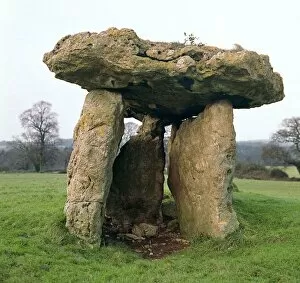5th Millennium Bc Collection
Discover the rich tapestry of the 5th millennium BC
For sale as Licensed Images
Choose your image, Select your licence and Download the media
Discover the rich tapestry of the 5th millennium BC, a time when ancient civilizations flourished and left behind remarkable artifacts that continue to captivate us today. Among these treasures are the enigmatic Double-Edged Bannerstone and Notched Ovate Bannerstone, both crafted by unknown hands between 5800 and 4000 B. C. , showcasing intricate designs that hint at their ceremonial or symbolic significance. Traveling to Catalhoyuk in Turkey, we encounter a mesmerizing sculpture depicting a seated goddess on a throne, flanked by two majestic lionesses. This awe-inspiring piece transports us back to an era where deities were revered and worshipped with great devotion. Moving westward to St Lythans in Wales, we stumble upon an extraordinary Neolithic burial chamber from the 5th millennium BC. Standing as a testament to ancestral reverence for the deceased, this sacred site offers glimpses into ancient burial rituals and beliefs surrounding life after death. Venturing eastward towards Mesopotamia in Iraq, painted ceramic bowls from Tell Hassan catch our eye. These intricately decorated vessels showcase exquisite craftsmanship while providing insights into daily life during this period of history. A ceramic vase adorned with geometric patterns further highlights the artistic prowess of its creators. Our journey takes us next to Italy where we discover a bowl featuring an anthropomorphic figure. This peculiar artifact invites speculation about its purpose – was it used for ritualistic ceremonies or perhaps held some deeper cultural significance? Returning once more to Tell Hassan in Iraq, painted ceramic pots abound – each one telling its own story through vibrant colors and intricate motifs. These vessels offer glimpses into domestic life during this era while highlighting humanity's innate desire for beauty even amidst practicality. Finally, we encounter plows and tools made of bone discovered in China's Hemudu culture (Zhejiang). These humble yet ingenious creations remind us of humanity's resourcefulness during prehistoric times, as our ancestors harnessed the natural world to shape their existence.










